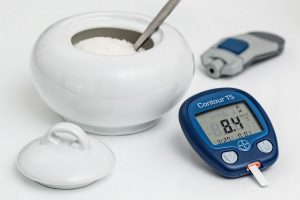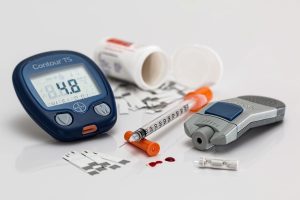
Type 2 diabetes is a chronic, lifelong health condition in which the body is unable to properly regulate the amount of sugar in the bloodstream. It is the most common form of diabetes, and affects over 30 million people in the United States alone. Without adequate management, type 2 diabetes can have serious, long-term health consequences, including blindness, kidney failure, heart disease, stroke, and nerve damage.
Causes of Type 2 Diabetes
Genetics can be a major contributing factor to the development of type 2 diabetes. Studies have shown that children of parents with type 2 diabetes are at a higher risk of developing the condition themselves. This is likely because some people have a genetic predisposition to the condition, and their lifestyle choices can further increase their risk. Additionally, age is a factor, as people over 45 are at a higher risk of developing type 2 diabetes.
Lifestyle choices are also contributing factors for type 2 diabetes. Poor dietary choices, such as an excess of processed foods and sugary drinks, can increase the risk of developing type 2 diabetes. A lack of physical activity can also be a factor, as it can lead to obesity, which is a risk factor for developing type 2 diabetes. Additionally, smoking, alcohol use, and other unhealthy habits can increase the risk of developing the condition.
Another factor that increases the risk of type 2 diabetes is a condition called insulin resistance. Insulin is a hormone produced by the pancreas that helps the body regulate blood sugar levels. When the body becomes resistant to insulin, the pancreas can’t produce enough of it to keep blood sugar levels in check, leading to type 2 diabetes. Insulin resistance can be caused by obesity, physical inactivity, and genetics.
There are also some medical conditions that can increase the risk of developing type 2 diabetes. These include polycystic ovary syndrome, a condition in which the ovaries become enlarged and produce too much of the hormone testosterone. Additionally, Cushing’s syndrome, a condition in which the body produces too much of the hormone cortisol, can lead to insulin resistance and type 2 diabetes.
Stress and trauma can also increase the risk of type 2 diabetes. Research has shown that chronic stress can lead to changes in insulin production, making the body less sensitive to insulin. Additionally, trauma and depression can lead to changes in lifestyle choices, such as overeating and a lack of physical activity, which can further increase the risk of developing type 2 diabetes.
Symptoms of Type 2 Diabetes
The most common symptom of type 2 diabetes is excessively high blood sugar levels. While the normal range of blood sugar is between 70 and 120 mg/dL, a person with diabetes may have levels higher than 200 mg/dL. Other symptoms of type 2 diabetes include increased thirst, frequent urination, and blurred vision. Unexplained weight loss, fatigue, and an increased appetite can also indicate the presence of diabetes.
In addition to these more obvious symptoms, type 2 diabetes can also cause a variety of complications. One of the most serious is retinopathy, a condition in which the blood vessels in the eye become damaged and can lead to vision loss. Neuropathy, or nerve damage, is another complication that can cause tingling, numbness, and pain in the hands and feet. People with type 2 diabetes are also at an increased risk of developing kidney disease and cardiovascular disease.
Diagnosis of Type 2 Diabetes
It is important to understand the diagnosis of type 2 diabetes, so that individuals can take the necessary steps to manage their condition and prevent serious complications.
The diagnosis of type 2 diabetes typically begins with a discussion between the patient and their healthcare provider. During this appointment, the provider will ask about the patient’s medical history, including any previous diagnosis of diabetes, as well as any family history of the condition. The provider may also review the patient’s lifestyle and any related risk factors, such as obesity or a sedentary lifestyle. Physical examination may be performed to check for signs of type 2 diabetes, such as excess thirst, frequent urination, and unexplained weight loss.
After the physical examination, the doctor may order certain tests to confirm a diagnosis of type 2 diabetes. The most common test is a fasting plasma glucose (FPG) test, which measures the amount of glucose in the blood after the patient has not eaten for at least 8 hours. An oral glucose tolerance test (OGTT) may also be performed to measure how the body responds to glucose after a meal. If these tests indicate that the patient has type 2 diabetes, the doctor may order additional tests, such as an A1C test, to monitor the patient’s blood sugar levels over time.

Prevention of Type 2 Diabetes
The first step in preventing type 2 diabetes is to maintain a healthy lifestyle. Eating a balanced diet that is low in saturated fat and processed sugars and high in fiber, whole grains, and fresh fruits and vegetables is essential for maintaining good health. Exercise is also important for keeping blood sugar levels in check and can help reduce the risk of developing diabetes. By engaging in physical activity on a regular basis, including walking, jogging, cycling, swimming, and other aerobic activities, individuals can help maintain their weight and reduce the risk of developing type 2 diabetes.
Another important step in preventing type 2 diabetes is to monitor blood sugar levels. This can be done through regular blood sugar testing, which is an essential part of diabetes management and prevention. Regular blood sugar tests can help identify any abnormalities so that they can be addressed before they lead to more serious conditions.
In addition to lifestyle changes and blood sugar monitoring, other strategies can help reduce the risk of type 2 diabetes. These include managing stress levels, getting adequate sleep, and quitting smoking. Stress can negatively affect blood sugar levels, so it is important to prioritize managing stress levels and engaging in activities that help reduce stress. Getting adequate sleep is important for maintaining good health, and smoking should be avoided as it increases the risk of type 2 diabetes.
It is important to talk to a doctor about type 2 diabetes prevention. Doctors can provide advice on lifestyle changes and medications that can help reduce the risk of developing diabetes. Additionally, doctors can provide resources for learning more about type 2 diabetes and other health conditions.
Treatment of Type 2 Diabetes
Type 2 diabetes is a treatable condition and with the proper treatment, symptoms can be managed effectively.
The primary treatment for type 2 diabetes is lifestyle changes. This includes following a healthy diet, which should be tailored to the individual’s health needs, and engaging in regular physical activity. These changes can help to improve insulin sensitivity and reduce blood sugar levels. It is also important to lose weight if the individual is overweight or obese as this can help to improve glycemic control. Some people may also be prescribed medications to help lower their blood sugar levels. These drugs can vary depending on the individual’s needs and are typically taken on a daily basis.
In addition to lifestyle changes and medications, there are some additional treatments that can be used to help manage type 2 diabetes. One of these is self-monitoring of blood sugar levels, which involves regularly checking and recording your blood sugar levels at home. This can help to identify any changes in blood sugar levels which can help to guide the treatment plan. Other treatments include insulin therapy, which may be used if lifestyle changes and medications are not sufficient to maintain blood sugar control. It is important to note that insulin therapy is only used when absolutely necessary and can come with some risks.
A healthcare team is essential in managing type 2 diabetes. This team should include a doctor, a dietitian, and a diabetes educator. They can provide guidance and advice on how to best manage the condition. Regular sittings with the healthcare team are essential to monitor the progression of the disease and the effectiveness of the treatment.